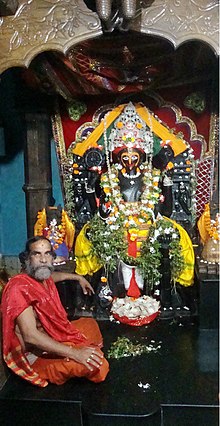Alarnatha Mandira

Alarnatha Mandira or Alvarnaatha Mandira (Sanskrit: अल्वार् नाथ), (Odia: ଅଲାରନାଥ) is a Hindu temple dedicated to Vishnu and located in Brahmagiri, Odisha, near Puri. It becomes crowded during the krishnapaksha of Ashadha, after the Snana Yatra when devotees are not allowed to see the central icon of Jagannath (a form of Vishnu) in his Puri temple. During this period, popularly known as Anasara or 'Anavasara' (literally meaning no opportunity to see the lord of Puri), instead of having darshan in the Puri temple, devotees believe that Jagannath during this time manifests as Alarnath Dev, at the Alarnath Mandira in Brahmagiri, which is about 23 km from Puri. It is considered one among the 108 Abhimana Kshethram of Vaishnavate tradition.
Historical evidence[edit]
The temple is associated with the visit of the saint Ramanujacharya to Odisha.[1] Chaitanya Mahaprabhu during his stay in Puri used to see the deity form of Jagannath daily. During Anavasara when Jagannath and his sibling deities were taken to the secret chamber for 15 days, he was unable to see the Lord. So as per legend, Jagannath directed him to go to Brahmagiri and visit the Alarnath temple. Still today the Shila over which Chaitanya Mahaprabhu used to do Sankirtana is there. Many historians opine that Alvars once visited this place, but there is no mention of it in Divyaprabandam. But still the temple is considered one among the 108 Abhimana Kshethram of Vaishnavate tradition.
Temple timings[edit]
The temple opens at 6 AM and closes at 9:30PM. Baal Bhoga (breakfast) is offered in the morning. At midday, different kinds of rice, daal, and vegetable curries are offered along with kheeri (rice pudding) as dessert. At night, different kinds of pitha and khichudi with plantain fry is offered. During Anavasara time the Kheeri bhoga offered to Alvarnaath Swami is much hyped and in demand.
References[edit]
- ^ K.K. Kusuman (1990). A Panorama of Indian Culture: Professor A. Sreedhara Menon Felicitation Volume. Mittal Publications. p. 166. ISBN 978-81-7099-214-1.
